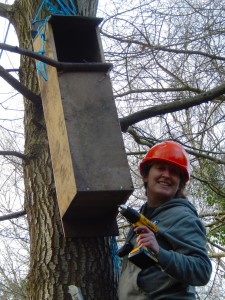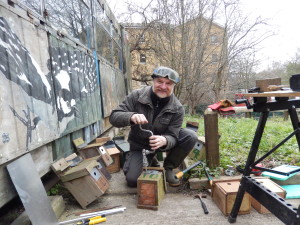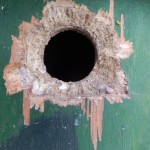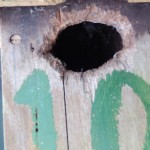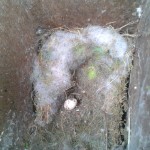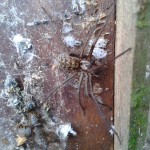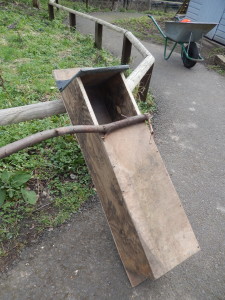
It was a very rainy workday, and with only two of us around we wondered what to do. It was time for an indoor project that we’d been putting off … make an owl box. Tawny Owls might seem surprising citydwellers, but they are around in the leafier suburbs and larger parks.
We looked at the RSPB website for instructions, calculated the measurements of all six faces of the box on a sheet of paper, and studied the bits of plywood we had available. Just whiz along with the circular saw, screw it all together and we’ll be done.
It took a little longer. To cut the wood, we needed to be outside. Where it was raining. The wood got wet and it was hopeless trying to draw lines in pencil or biro. Felt pen worked, sort of, but gave us thicker smudgier lines. We drew, went outside, held and sawed, dusted down, came inside, made another cup of tea, drew again, went outside.
Finally we had a forlorn pile of long, dirty, improbably shaped bits. They seemed nothing like a nestbox. Let’s finish it next time, said Netty, sounding a lot less keen than she had at the start. Let’s get it done, I said. It’ll not take long now. We were a bit cold. We screwed the front to the sides, which were the thickest parts. Suddenly it had a shape. We took the extraordinarily long back and screwed it to the sides. A box. A very long box. We pushed the base into the hole. It wobbled. We pushed it down the very long hole with an umbrella and got some screws in. It was all done save the lid, which needed waterproofing with some roofing felt, and attaching with a rubbery damp-course hinge.
The next time was dry, and we took the box outside. It seemed enormous, and Netty had fixed on a long bit of dead branch as an owl-perch, but it went in a wheelbarrow and we set off with drill, ropes, and a ladder to the chosen Oak, a tall straight tree off the beaten track.
We managed to get a rope over a branch and haul the box up. Only, how to fix it and get the rope down again? We let it down, threw a thin plastic rope over the branch as well, hauled the box up, tied the thin rope onto the top of the box, and stood back. The box was up, but definitely dangling. We could easily fix some screws into the stub at the base of the box, but how to do the same for the stub at the top? We moved the ladder around the tree to find a way to reach. With the ladder in the easiest place, the box was directly above our heads. We tried it every which way, we couldn’t reach. We put the ladder back where it was. With two of us holding the ladder and one on the top rung, it was just possible. Trying to tie knots or fix a screw with one hand … is quite tricky. We were very pleased when it was done. We’ll be delighted if a family of owls takes up residence. Or even some jackdaws.
